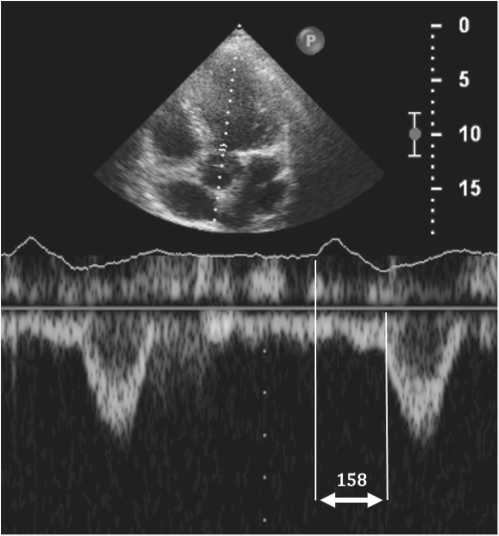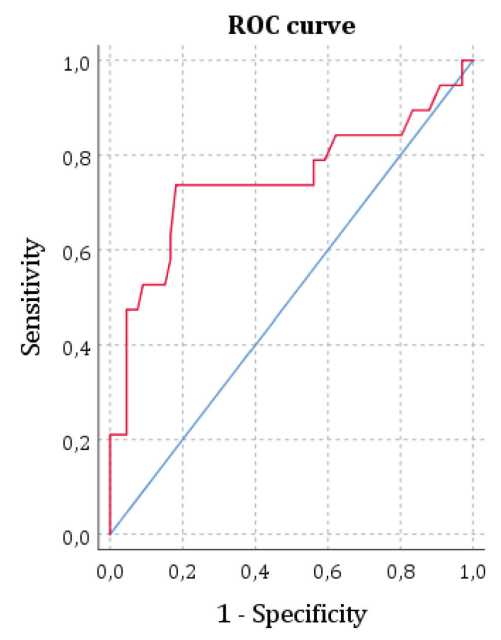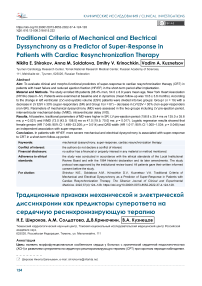Traditional criteria of mechanical and electrical dyssynchrony as a predictor of super-response in patients with cardiac resynchronization therapy
Автор: Shirokov N. E., Soldatova A. M., Krinochkin D. V., Kuznetsov V. A.
Журнал: Сибирский журнал клинической и экспериментальной медицины @cardiotomsk
Рубрика: Клинические исследования
Статья в выпуске: 4 т.37, 2022 года.
Бесплатный доступ
Aim: To evaluate clinical and morpho-functional predictors of super-response to cardiac resynchronization therapy (CRT) in patients with heart failure and reduced ejection fraction (HFrEF) in the short-term period after implantation.Material and Methods. The study enrolled 86 patients (88.4% men, 54.0 ± 8.9 years mean age, New York Heart Association (NYHA) class II-IV). Patients were examined at baseline and in dynamics (mean follow-up was 10.6 ± 3.6 months). According to the change in left ventricular (LV) end-systolic volume (ESV) patients were divided into two groups: Group I (n = 19) with a decrease in LV ESV ≥ 30% (super-responders (SR) and Group II (n = 67) - decrease in LV ESV
Mechanical dyssynchrony, super-response, cardiac resynchronization therapy
Короткий адрес: https://sciup.org/149141443
IDR: 149141443 | УДК: 616.12-008.318:615.222 | DOI: 10.29001/2073-8552-2022-37-4-124-128
Текст научной статьи Traditional criteria of mechanical and electrical dyssynchrony as a predictor of super-response in patients with cardiac resynchronization therapy
Широков Н.Е., Солдатова А.М., Криночкин Д.В., Кузнецов В.А. Традиционные признаки механической и электрической диссинхронии как предикторы суперответа на сердечную ресинхронизирующую терапию. Сибирский журнал клинической и экспериментальной медицины. 2022;37(4):124–128.
Asynchronous left ventricular (LV) function in patients with heart failure and reduced ejection fraction (HFrEF) with the presence of left bundle branch block (LBBB) and wide QRS complex are recognized as the main criteria for the selection to cardiac resynchronization therapy (CRT) by the current guidelines [1]. CRT is associated with the potential reversibility of cardiac remodeling [2]. Improvement of long-term survival in patients with HFrEF following CRT implantation are proportional to the degree of improvement of LV systolic function. Patients with pronounced reverse remodeling after CRT are identified as super-responders (SR) [3].
Non-ischemic etiology of cardiomyopathy, female sex, LBBB and QRS width among various factors are described to be associated with super-response to CRT [4, 5]. However, several studies have shown that the criteria of intraventricular and interventricular mechanical dyssynchrony (MD) are more accurate predictors of super-response to CRT [6, 7].
The purpose of this study is to evaluate clinical and morpho-functional features in patients with HFrEF and super-response to CRT and to determine predictors of super-response in a short-term follow-up period.
Material and Methods
The study enrolled 86 patients included in “The register of performed operations of cardiac resynchronization therapy”© (88.4% men, mean age 54.0 ± 8.9 years, 58.2% with LBBB, 54.7% with ischemic cardiomyopathy) [8]. The main criteria for the selection of patients were: NYHA functional class II– IV, LV EF ≤35%; markers of intraventricular and/or interventricular MD recorded with two-dimensional echocardiography (2D Echo). Standard echocardiography was performed using a commercially available system Philips IE 33. The examination included 2D Echo grayscale, color and tissue Doppler imaging (TDI). Using 2D echocardiography, we evaluated LV end-diastolic volume (EDV), LV end-systolic volume (ESV) and LV ejection fraction (LVEF).
Super-response was defined as a decrease of LV ESV ≥ 30% at the follow-up visit. According to the change in LV ESV, patients were divided into two groups: group I ( n = 19) with a decrease in LV ESV ≥30% (SR); and group II ( n = 67) with a decrease in LV ESV < 30% (non-super-responders, non-SR).
As for dyssynchrony parameters, two MD indexes were quantified by 2D echocardiography: interventricular mechanical delay (IVMD), defined as the delay in onset of outflow between the left and right ventricle (abnormality cut-off > 40 ms); and LV pre-ejection period (PEP) (abnormality cut-off > 140 ms) (Figure 1). IVD was assessed by TDI, based on the difference between time to onset of systolic velocity spectrum recorded from lateral and septal mitral annulus from 4-chamber apical view asynchrony (abnormality cut-off > 60 ms) [9].
The patient examination was performed at baseline and during the follow-up (10.6 ± 3.6 months). All patients were on optimal drug therapy according to current guidelines [1].
Statistical analyses were performed using SPSS for Windows version 23.0 (SPSS Inc., Chicago, IL, USA). Categorical variables were reported as count and percent and compared by χ2 exact test. Continuous variables were tested for normality by the Kolmogorov-Smirnov test and reported as mean and SD or median and quartiles as appropriate. Student’s t-test and Mann – Whitney Wilcoxon test were used for comparing continuous variables expressed as means and medians, respectively. P value < 0.05 was considered statistically significant.

Fig. 1. Increase of left ventricular pre-ejection period in patient with superresponse to cardiac resyncronuzation therapy.
Рис. 1. Увеличение периода аортального предызгнания у пациента с суперответом на сердечную ресинхронизирующую терапию.
Results
Compared to Group II (non-SR), Group I (SR) were less likely to be males (63.2% vs 95.5%; р < 0.001). There were no significant differences between the groups with respect to the 6 minute walk test (6MWT) (SR 315.6 vs non SR 295.1; р = 0.461), NYHA functional class (SR 1.8 vs non SR 2.0; p = 0.178) and all other characteristics (Table 1).
At the follow up visit, there was still no statistically significant difference with respect to the 6MWT (SR 414.9 vs non SR 379.9; р = 0.183) and NYHA functional class (SR 1.8 vs non SR 2.0; р = 0.178).
The SR group exhibited more pronounced manifestations of MD and QRS duration. The LV PEP and IVMD were significantly higher (Table 2).
During the follow-up, a statistically significant improvement in echocardiographic parameters was noticed in both groups, with comparing initial data, along with LV ESV, which was used as the separation criterion. Significantly lower values of LV EDV and greater LV EF were found in Group I on the follow-up visit (Table 2).
Table 1. Baseline characteristics of study participants ( n = 86)
Таблица 1. Клинико-функциональная характеристика пациентов
|
Feature Показатель |
Group I ( n = 19) Группа I |
Group II ( n = 67) Группа II |
р |
|
Age, years Возраст, годы |
54.7 ± 8.5 |
53.9 ± 9.1 |
NS нд |
|
Gender, % male Пол, % мужчины |
63.2 |
95.5 |
< 0.001 |
|
Ischemic CMP, % ИБС, % |
52.6 |
55.2 |
NS нд |
|
Atrial fibrillation, % ФП, % |
15.8 |
40.3 |
NS нд |
|
Diabetes, % СД, % |
21.1 |
11.9 |
NS нд |
|
Arterial hypertension, % А, % |
84.2 |
68.7 |
NS нд |
|
History of MI, % ИМ в анамнезе, % |
26.3 |
44.8 |
NS нд |
|
LBBB, % БЛНПГ, % |
73.7 |
52.2 |
NS нд |
|
QRS, ms |
165.7± 42.7 |
136.3 ± 33.7 |
0.006 |
|
СRТ-D, % СРТД, % |
52.6 |
71.6 |
NS нд |
Note: CMP – cardiomyopathy; MI – myocardial infarction; LBBB – left bundle branch block; CRT-D – combined system for cardiac resynchronization therapy with cardioverter-defibrillator function; NS – non significant ( p > 0.05).
Примечание. ИБС – ишемическая болезнь сердца, ФП – фибрилляция предсердий, СД – сахарный диабет, АГ – артериальная гипертензия, ИМ – инфаркт миокарда, БЛНПГ – блокада левой ножки пучка, СРТ-Д – комбинированная система для сердечной ресинхронизирующей терапии с функцией кардиовертера-дефибриллятора, нд – нет достоверных различий, ( р > 0,05).
Table 2. Echocardiographic parameters of study participants ( n = 86)
Таблица 2. Динамика эхокардиографических параметров ( n = 86)
|
Feature Показатель |
Group I ( n = 19) I группа ( n = 19) |
Group II ( n = 67) II группа ( n = 60) |
р |
|
|
LV EF, % ФВ ЛЖ, (%) |
at baseline исходно |
30.6 ± 6.2 |
30.6 ± 5.2 |
NS нд |
|
control контрольно |
45.3 ± 7.2* |
34.9 ± 6.2* |
< 0.001 |
|
|
LV EDV, ml КДО ЛЖ, (мл) |
at baseline исходно |
240.7 ± 59.4 |
239.9 ± 58.2 |
NS нд |
|
контрольно |
190.9 ± 48.6* |
230.4 ± 59.1* |
0.002 |
|
|
LV ESV, ml КСО ЛЖ, (мл) |
at baseline исходно |
172.4 ± 52.2 |
168.1 ± 48.8 |
NS нд |
|
контрольно |
104.6 ± 31.9* |
152.9 ± 50.3* |
< 0.001 |
|
|
LV pre-ejection period, ms Период аортального предызгнания, (мсек) |
at baseline исходно |
156.8 ± 35.4 |
135.0 ± 35.6 |
0.021 |
|
Mechanical interventricular delay, ms Механическая межжелудочковая задержка, (мсек) |
at baseline исходно |
73.0 [43.0; 108.0] |
47.0 [19.5; 70.0] |
0.017 |
|
Intraventricular delay by TDI, ms Максимальная межсегментарная задержка, TDI, (мсек) |
at baseline исходно |
78.0 [40.0; 110.0] |
55.5 [28.8; 100.0] |
0.149 |
Note: LV – left ventricular; EF – ejection fraction; EDV – end-diastolic volume; ESV – end-systolic volume; TDI – tissue Doppler; * – significant relationship of control from initial ( p < 0,05); NS – non significant, ( p > 0.05).
Примечание: ФВ ЛЖ – фракция выброса левого желудочка; КДО ЛЖ – конечно-диастолический объем левого желудочка; КСО – конечно-систолический объем; КДД – конечно-диастолический диаметр; КСД – конечно-систолический диаметр; тканевая допплерография – TDI; * – значимая достоверность контроля от исходных данных ( р < 0,05); нд – нет достоверных различий, ( р > 0,05).
Logistic regression results showed that female gender (HR 7.048; 95% CI 1.496-33.206; p = 0.014) and QRS width (HR 1.017; 95% CI 1.000–1.034; p = 0.048) had an independent association with super-response. According to the ROC analysis, sensitivity and specificity of this model in the prediction of super-response to CRT were 73.7% and 81.7%, respectively. The area under the curve (AUC) was 0.746; p = 0.002, which indicates that the predictive model is of good quality (Fig. 2).

Fig. 2. Sensitivity and specificity of model in the prediction of superresponse to CRT were 73.7% and 81.7%, respectively
Рис. 2. Чувствительность и специфичность модели прогнозирования суперответа на СРТ: 73.7% и 81.7% соответственно
Discussion
Currently, there is no consensus on the follow-up period when the response to CRT should be assessed [10, 11]. In our study, changes in echocardiographic parameters were evaluated during the first year after implantation [11]. Besides that, the reverse LV remodeling in SR after CRT remains stable with long-term follow-up [3]. Despite the different definitions for super-response time, patients with super-response demonstrated better survival, better dynamics of clinical and functional features, and more significant increase in LVEF [12].
A subanalysis of the PROSPECT study showed that SR before the pacemaker implantation had more pronounced traditional criteria of electrical dyssynchrony and MD than responders, non-responders and patients with negative dynamics [6]. Compared with males, female patients were found to have more frequent electromechanical abnormalities at shorter QRS width [13]. In recent years, new methods of visualizing the myocardium (speckle tracking echocardiography) facilitate our understanding of the electromechanical background of LBBB [14]. It should be noted that baseline MD was shown to be a significant predictor of CRT efficiency [15–17]. While previous studies demonstrated that greater response was associated with LBBB and QRS width [18].
Of note in our study, at baseline, both groups were comparable in QRS morphology. Groups differed in the duration of QRS width, LV PEP and IVMD, which were significantly higher in the SR group.
Conclusion:
In patients with HFrEF, more severe mechanical and electrical dyssynchrony is associated with super-response to CRT.
Limitations
Enrollment began in January 2005 until July 2017. During this period, the selection criteria for CRT in current guidelines changed.
At baseline for implantation of biventricular pacemaker two main criteria were identified: decreased LVEF and the presence of MD. One of the first examples of use such an approach was the Protocol of St. Mary’s Hospital in London. The results of the MADIT-CRT study are reflected in the clinical guidelines of ESC in 2013. There was a requirement for a presence of QRS morphology by LBBB; which was not a criterion before. Clinical guidelines of ESC in 2016 confirm QRS width more than 150 ms; increasing from a previous cut-off of 120 ms.
In general, we used our experience of patient selection for CRT, from 2005 until the update to the guidelines for CRT in 2013, in our practice the protocol of St. Mary’s Hospital (London) for recommendation for CRT [9].
Список литературы Traditional criteria of mechanical and electrical dyssynchrony as a predictor of super-response in patients with cardiac resynchronization therapy
- Mareev V.Yu., Fomin I.V., Ageev F.T., Begrambekova Yu.L., Vasyuk Yu.A., Garganeeva A.A. et al. Clinical recommendations SSHF-RSC-RSMST. Heart failure: congestive (CHF) and acute decompensated (ADHF). Diagnosis, prevention and treatment. Kardiologiia. 2018;58(6S):8-158. (In Russ.). DOI: 10.18087/cardio.2475.
- Brignole M., Auricchio A., Baron-Esquivias G., Boriani G., Breithardt O.A., Cleland J. et al. ESC Guidelines on cardiac pacing and cardiac resynchronization therapy 2013: The Task Force on cardiac pacing and resynchronization therapy of the European Society of Cardiology (ESC). Developed in collaboration with the European Heart Rhythm Association (EHRA). Eur. Heart J. 2013;34(29):2281-2329. DOI: 10.1093/eurheartj/ eht150.
- Rickard J., Cheng A., Spragg D., Bansal S., Niebauer M., Baranows-ki B. et al. Durability of the survival effect of cardiac resynchroniza-tion therapy by level of left ventricular functional improvement: Fate of "nonresponders". Heart Rhythm. 2014;11(3):412-416. DOI: 10.1016/j. hrthm.2013.11.025.
- Ghani A., Delnoy P.P.H., Adiyaman A., Ottervanger J.P., Ramdat Mis-ier A.R., Smit J.J.J. et al. Predictors and long-term outcome of su-per-responders to cardiac resynchronization therapy. Clin. Cardiol. 2017;40(5):292-299. DOI: 10.1002/clc.22658.
- Jackson T., Sohal M., Chen Z., Child N., Sammut E., Behar J. et al. A U-shaped type II contraction pattern in patients with strict left bundle branch block predicts super-response to cardiac resynchronization therapy. Heart Rhythm. 2014;11(10):1790. DOI: 10.1016/j. hrthm.2014.06.005.
- Van Bommel R.J., Bax J.J., Abraham W.T., Chung E.S., Pires L.A., Tavazzi L. et al. Characteristics of heart failure patients associated with good and poor response to cardiac resynchronization therapy: A PROSPECT (Predictors of Response to CRT) sub-analysis. Eur. Heart J. 2009;30(20):2470-2477. DOI: 10.1093/eurheartj/ehp368.
- Cazeau S.J., Dauber J., Tavazzi L., Frohlig G., Paul V. Responders to cardiac resynchronization therapy with narrow or intermediate QRS complexes identified by simple echocardiographic indices of dyssynchrony: the DESIRE study. Eur. Heart J. 2008;10(3):273-280. DOI: 10.1016/j.ejheart.2008.02.007.
- Kuznetsov V.A., Kolunin G.V., Kharats V.E. et al. Register of performed operations of cardiac resynchronization therapy. Electronic database, state registration №2010620077 from 01.02.2010. (In Russ.).
- Kuznetsov V.A. Cardiac resynchronization therapy: selected questions. Moscow: Abys; 2007:128. (In Russ).
- Yanagisawa S., Inden Y., Shimano M., Yoshida N., Fujita M., Ohguchi S. et al. Clinical characteristics and predictors of super-response to cardiac resynchronization therapy: a combination of predictive factors. Pacing Clin. Electrophysiol: РАСЕ. 2014;37(11):1553. DOI: 10.1111/pace.12506.
- Vukajlovic D., Milasinovic G., Angelkov L., Ristic V., Tomovic M., Jurcev-ic R. et al. Contractile reserve assessed by dobutamine test identifies super-responders to cardiac resynchronization therapy. Arch. Med. Sci. 2014;10(4):684. DOI: 10.5114/aoms.2014.40790.
- Cay S., Ozeke O., Ozcan F., Aras D., Topaloglu S. Mid-term clinical and echocardiographic evaluation of super responders with and without pacing: the preliminary results of a prospective, randomized, single-centre study. Europace. 2016;18(6):842. DOI: 10.1093/europace/euv129.
- De Pooter J., Kamoen V., El Haddad M., Stroobandt R., De Buyzere M., Jordaens L. Gender differences in electro-mechanical characteristics of left bundle branch block: Potential implications for selection and response of cardiac resynchronization therapy. Int. J. Cardiol. 2018;257:84-91. DOI: 10.1016/j.ijcard.2017.10.055.
- Shirokov N.E., Kuznetsov V.A., Todosiychuk V.V., Soldatova A.M., Kri-nochkin D.V. Relationship between left bundle branch block patterns and super-response to cardiac resynchronization therapy in patients with heart failure. Russian Journal of Cardiology. 2021;26(7):4227. (In Russ.). DOI: 10.15829/1560-4071-2021-4227.
- Cleland J.G., Daubert J.C., Erdmann E., Freemantle N., Gras D., Kap-penberger L. et al. The effect of cardiac resynchronization on morbidity and mortality in heart failure. N. Engl. J. Med. 2005;352(15):1539-1549. DOI: 10.1056/NEJMoa050496.
- Kuznetsov V.A., Soldatova A.M., Krinochkin D.V., Enina T.E. Cardiac resynchronisation therapy for congestive heart failure: whether we should expect for an "early" response? Russian Heart Failure Journal. 2017;18(3):172-177. (In Russ). DOI: 10.18087/rhfj.2017.3.2341.
- Gold M.R., Yu Y., Wold N., Day J.D. The role of interventricular conduction delay to predict clinical response with cardiac resynchroniza-tion therapy. Heart Rhythm. 2017;14(12):1748-1755. DOI: 10.1016/j. hrthm.2017.10.016.
- Van der Bijl P., Khidir M., Leung M., Mertens B., Ajmone Marsan N., Delgado V. et al. Impact of QRS complex duration and morphology on left ventricular reverse remodeling and left ventricular function improvement after cardiac resynchronization therapy. Eur. J. Heart Fail. 2017;19(9):1145-1151. DOI: 10.1002/ejhf.769.


